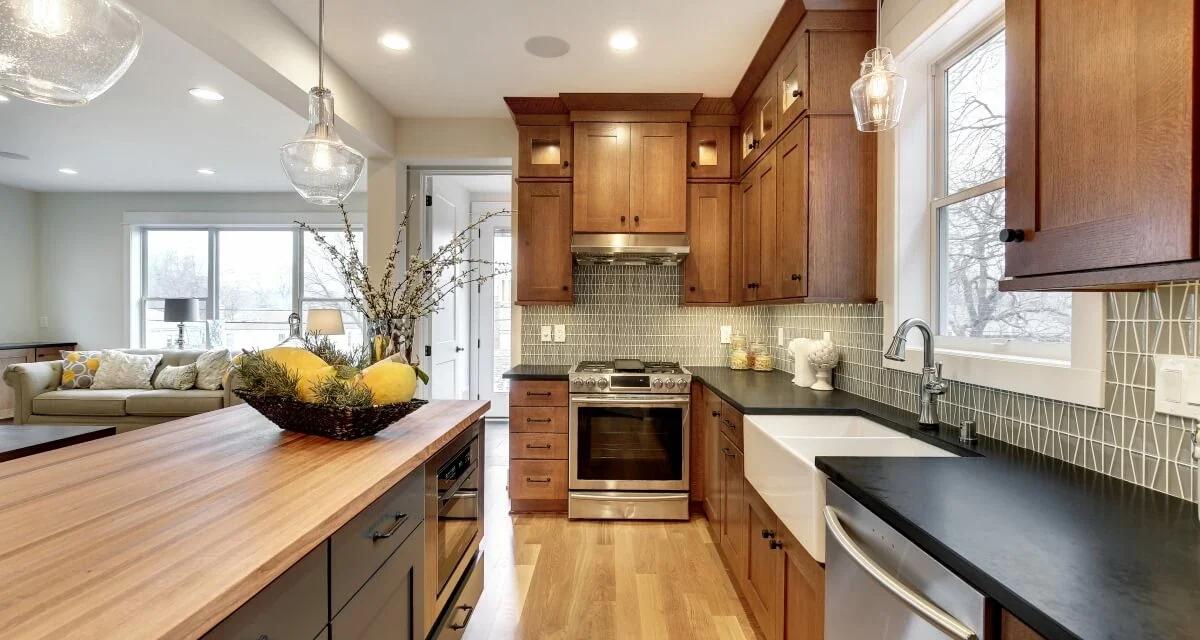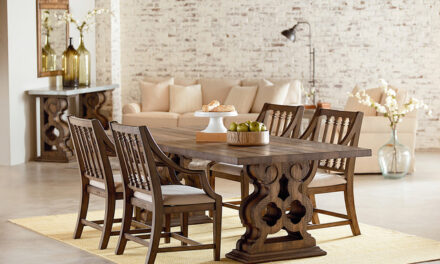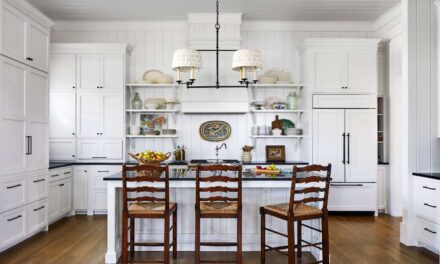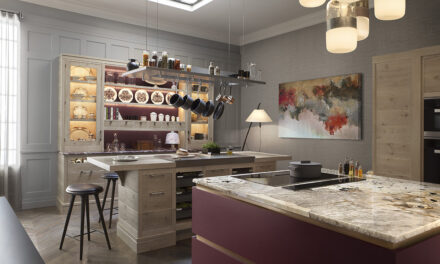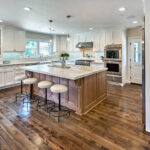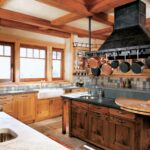A Craftsman home kitchen blends the charm of traditional design with the warmth and functionality that defines this iconic architectural style. Rooted in simplicity and handcrafted detail, the Craftsman home kitchen is more than a cooking space—it’s the heart of the home.
These kitchens often feature rich, natural materials like wood and stone, with cabinetry and built-ins that showcase the artistry of skilled craftsmanship. Cabinet doors are usually adorned with simple, clean lines, and often accented with glass or metal hardware that complements the rustic aesthetic.
Open shelving, exposed beams, and large windows create an airy, inviting atmosphere, making it a perfect setting for family gatherings or quiet moments with a cup of coffee. The color palette tends to be earthy and warm, incorporating hues of deep greens, browns, and creams that echo the natural surroundings.
Modern amenities like high-end appliances and sleek countertops can be seamlessly integrated without compromising the authentic, cozy feel of the space. Whether you’re cooking a meal or enjoying a quiet evening, a Craftsman kitchen offers both timeless beauty and practical comfort, blending old-world charm with contemporary convenience. It’s a space designed not just for function, but for fostering connection and relaxation.
Handcrafted Heritage: The Soul of a Craftsman home Kitchen
The allure of Craftsman home kitchens lies in their authenticity, beauty, and craftsmanship. Unlike kitchens mass-produced or overly modernized, a Craftsman kitchen exudes character, detail, and an organic warmth that’s unique to the American Arts and Crafts movement. For those drawn to timeless aesthetics, practical layouts, and natural materials, a Craftsman kitchen is the heart of a home where heritage meets functionality. For more information visit here.
Table of Contents
The Origins of the Craftsman Kitchen
Craftsman kitchens are rooted in the Arts and Crafts movement, which began in the late 19th century as a response to the Industrial Revolution. Pioneers like William Morris and Gustav Stickley believed in reviving traditional craftsmanship, honoring handmade quality, and emphasizing natural materials over mass production. In America, this evolved into the Craftsman style, which found popularity through architectural designs by the Greene brothers and other early 20th-century architects. Their influence created homes with simple lines, solid woodwork, and a focus on craftsmanship—a style that continues to resonate today.
Essential Elements of a Craftsman Kitchen
craftsman home kitchen aren’t just about visual appeal; they’re designed to be functional, comfortable, and filled with rich details. Here are some defining features of these timeless spaces:
a. Wood as a Central Element
Wood is essential in a Craftsman kitchen, often showcased in natural finishes or rich stains that highlight its natural grain. Traditional woods like oak, cherry, and walnut lend a warm, earthy tone that anchors the space. From custom cabinetry to exposed beams, the use of wood brings both durability and a touch of nature indoors.
b. Handcrafted Cabinetry and Joinery
Craftsman cabinetry is known for its dovetail joints, mortise-and-tenon construction, and lack of ostentation. The focus is on simple, sturdy lines with meticulously crafted details like inlays, mullioned glass doors, or delicate hardware that add depth to the design. When considering cabinetry for a craftsman home kitchen, opt for pieces that emphasize clean lines, built-in storage, and a sense of permanence.
c. Earthy Color Palette
A Craftsman kitchen typically features a warm, earthy color palette with shades like olive green, amber, terracotta, and soft blues. These colors bring a grounded feel and pair beautifully with the natural materials that define the Craftsman style.
d. Artisan Lighting
Lighting in a craftsman home kitchen goes beyond mere function. Pendant lights, wall sconces, and chandeliers often feature stained glass, mica, or metal accents to create a soft, ambient glow. Art glass shades and Tiffany-style fixtures bring a touch of artistry and craftsmanship, enhancing the kitchen’s overall character.
e. Natural Stone and Ceramic Tiles
For flooring and backsplashes, materials like slate, limestone, and ceramic tiles are common in craftsman home kitchen. These materials add texture and richness, blending seamlessly with the wooden elements. Patterns are often simple, avoiding elaborate designs in favor of classic, understated layouts that add elegance without overpowering the space.
Designing a Craftsman Kitchen with Modern Comforts
Modernizing a Craftsman kitchen doesn’t mean compromising on authenticity. Here are some ways to keep a Craftsman kitchen’s charm while incorporating today’s comforts:
a. Energy-Efficient Appliances
While the Arts and Crafts movement didn’t have today’s appliances, a Craftsman kitchen can incorporate modern conveniences that don’t detract from its aesthetic. Stainless steel, black, or matte-finished appliances blend in without drawing too much attention.
b. Thoughtful Storage Solutions
Storage is essential in a well-organized kitchen, and modern storage solutions can be added discreetly in a craftsman home kitchen style. Think pull-out pantries, custom cabinetry with soft-close features, and drawer organizers that keep everything within easy reach. Maintaining a tidy, organized kitchen is an extension of the Craftsman ideal of functionality.
c. Sustainability and Eco-Friendly Materials
True to the craftsman home kitchen ethos of honoring nature, many homeowners today choose sustainable materials when updating a Craftsman kitchen. Reclaimed wood, recycled glass countertops, and energy-efficient lighting are all ways to bring environmental awareness into the kitchen’s design.

Creating the Craftsman Kitchen Ambiance
craftsman home kitchen embody a sense of warmth, intimacy, and craftsmanship. Here are some techniques to capture that ambiance:
a. Open Shelving and Plate Racks
Open shelving is a hallmark of the craftsman home kitchen style, providing display space for ceramics, pottery, and other artisan-made items. Plate racks can be installed above countertops or as part of cabinetry, adding charm and character while making dishes accessible.
b. Handcrafted Details
Look for pieces with handcrafted details, whether they’re pottery mugs, handwoven rugs, or decorative wooden bowls. These touches add personality and reflect the spirit of the Arts and Crafts movement. Even adding a hand-carved wooden spice rack can make a difference.
c. Cozy Nooks and Seating Areas
A Craftsman kitchen often includes cozy breakfast nooks or built-in seating that encourages gathering. To add this feature, consider a window seat with storage beneath, or a small, rounded table with classic, high-backed chairs. These intimate spaces evoke a time when families gathered around the kitchen as the heart of the home.
Craftsman Kitchen Decor and Accessories
Decorating a craftsman home kitchen means paying attention to even the smallest details. Accessories that complement the style can enhance the kitchen’s character and create a sense of harmony:
a. Artisan Pottery and Dishware
Ceramic dishware, hand-thrown bowls, and artisanal plates reflect the Arts and Crafts aesthetic. Displaying these items on open shelves can add both color and texture to the kitchen.
b. Wrought Iron and Brass Hardware
Cabinet handles, drawer pulls, and even light switch plates in wrought iron or brass can add an authentic feel to a craftsman home kitchen. Hardware should be simple yet solid, complementing the overall look without drawing too much attention.
c. Vintage-Inspired Textiles
Linens, curtains, and towels in vintage patterns or with simple embroidered details can add subtle beauty to the kitchen. Earthy colors, simple patterns, and natural fabrics like cotton or linen are ideal for maintaining a cohesive look.
Budget-Friendly Tips for a Craftsman Kitchen
craftsman home kitchen can be budget-friendly with a few thoughtful adjustments:
a. DIY Wooden Shelves and Furniture
Consider adding DIY shelving or small pieces of wooden furniture. Repurposing old wood or adding a fresh stain to inexpensive pieces can bring a custom look without high costs.
b. Add a Simple Tile Backsplash
A tiled backsplash can be both affordable and stylish. Subway tiles or square ceramic tiles in muted earth tones can create an elegant, Craftsman-inspired backsplash without breaking the bank.
c. Look for Artisan Finds at Flea Markets or Online Shops
Flea markets, thrift stores, and online marketplaces are excellent places to find unique, budget-friendly decor. Look for vintage light fixtures, pottery, or furniture that complement the Craftsman style.
Why a Craftsman Kitchen is Worth the Investment
A craftsman home kitchen is an investment in both style and substance. With its timeless beauty, high-quality materials, and thoughtful craftsmanship, a Craftsman kitchen can add lasting value to your home. This design style appeals to homeowners looking for more than just a functional space; it provides an atmosphere of warmth, authenticity, and connection to the past.
Conclusion
Creating a Craftsman home kitchen is about more than following a design style—it’s about embracing a philosophy that values quality, artistry, and a deep respect for materials and craftsmanship. Whether you’re renovating or designing from scratch, a Craftsman kitchen offers a beautiful, welcoming space that invites you to enjoy the art of cooking and the beauty of a thoughtfully crafted home.e heart of the home. In this space, meals are not just prepared; they’re crafted with care, love, and a sense of history.

